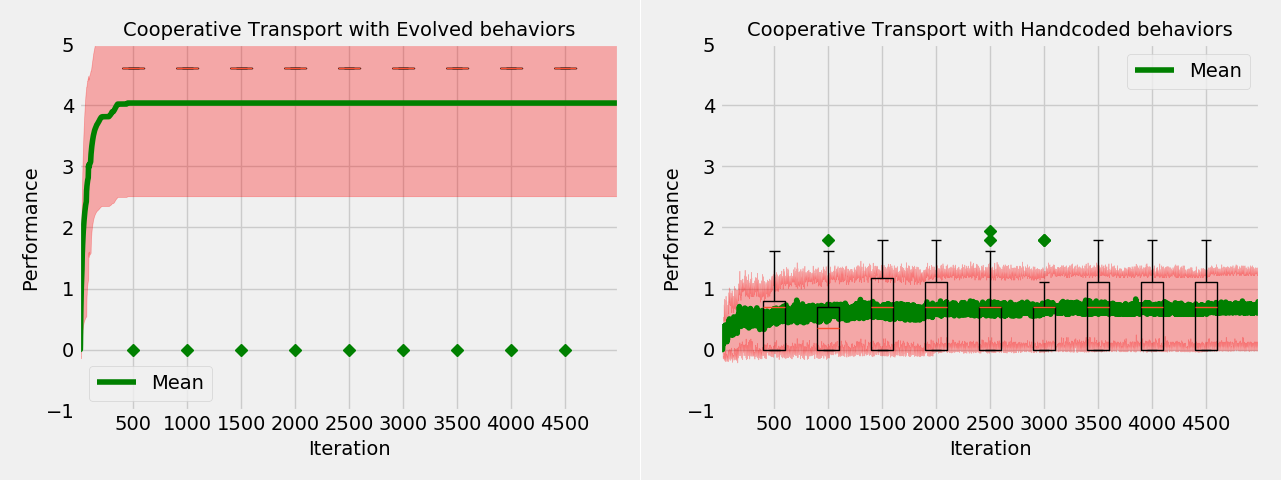Emergence of Collective Behaviors in Hub-Based Colonies using
Grammatical Evolution
and
Behavior Trees
Aadesh Neupane
Problem
- Designing collective behaviors is cumbersome
- Requires experts for modeling
Solution
- Evolutionary computation to generate collective behaviors
$$\frac{dR}{dt} = -aR + vnD , R(0) = R_0$$
$$\frac{dO}{dt} = aR -bO +cE, O(0) = O_0$$
$$\frac{dE}{dt} = q(D)bO - cE, E(0) = E_0$$
$$\frac{dA}{dt} = p(D)bO - mA + wnD$$
$$\frac{dD}{dt} = mA - nD, D(0) = D_0$$
Reference: Stability of choice in the honey bee nest-site selection process

Presentation Structure
- Demo
- Related work
- GEESE
- Challenges
- Validation
- Summary
Real Ants
Demo
Single Source Foraging
Demo
Cooperative Transport
Demo
Nest Maintenance
Related Work - Evolutionary Robotics
Reference: Evolution of collective behaviors for a real swarm of aquatic surface robots
- Swarm behaviors like homing, dispersion, clustering and monitoring by Duarte et. at
- Validation of scalability, flexibility, and robustness on transferred controller
Neural Network based controllers
Merits
- Easy mapping from sensory inputs into actuators values
- Provides generalized solutions
- Only a few human inputs needed
Demerits
- Issues with reverse engineering
- Insights on collective behavior difficult
- Almost impossible to modify the behaviors
Related Work - Evolutionary Robotics
Reference: GESwarm: Grammatical Evolution for the Automatic Synthesis of Collective Behaviors in Swarm Robotics
- Foraging problem using GE by Ferrante et. al.
- Preconditions, low-level behavior and actions gave behaviors
Grammatical Evolution (GE) based controllers
Advantages
Disadvantages
- BNF grammar and objective function
- Analyzing and modifying collective behaviors easier
- Primitive low-level rules defined by experts
- Mapping to raw sensors and actuators values difficult
Related Work - Behavior Tree
Reference: Behavior Trees for Evolutionary Robotics
DelFly Explorer
Related Work - Evolution
Reference: odNEAT: An algorithm for distributed online, onboard evolution of robot behaviours
odNEAT
- Online distributed evolution of Neural networks
- Applicable for online learning in groups of embodied agents (robots)
- Performs well in aggregation task
Combination of best features from all these works?
- A multi-agent Grammatical Evolution with BT
GEESE


















GEESE





Hello! Neighbour!
How are you doing with the phenotype in this environment?
Hello!
I collected 35 oz of water with the phenotype.
Take my genome and perform magic using genetic operators !
Agent

Initialization

GEESE Pipeline

Simulator

BNF Grammar - Swarms

Swarm Behaviors




Composite Carry
Composite Drop
Move Towards
Explore
Challenges
Non-episodic learning

Partially observable

Huge search space
Credit Assignment
Solution - Fitness Functions
Task-Specific
- Foraging : Total food collection in hub
- Cooperative Transport : Total heavy object collected in hub
- Nest Maintenance : Total debris removed from hub
Spatial
- Exploration : Area explored
- Prospective : Total objects carried
Diversity
- Phenotypic Diversity : Total unique behaviors
Thesis Statement
The interaction of hundreds of agents within the framework of distributed grammatical evolution will increase the effectiveness of evolving collective behaviors of bio-swarms. The evolved behaviors can be reused for different collective problems that have similar properties. Furthermore, with a slight variation of the objective function, the same set of primitive behaviors, encoded in the grammar, can lead to collective behaviors over a wider range of collective problems.
Validation
| Claim | Metric |
|---|---|
| Effectiveness | Quality solutions in fewer generations |
| Robustness | Same behavior for both single and multiple foraging problem |
| Breadth |
Solutions for Foraging and cooperative transport problem |
Validation

Effectiveness

Validation
Effectiveness

Solves the Santa Fe Trail in 324 steps
GE [Novelty] solved in 331 steps
Validation
- Breadth
Cooperative Transport
Nest Maintenance


Cooperative Transport

Nest Maintanence

Interesting Foraging Behavior
Interesting Nest Maintenance behavior
Summary
| Claims from thesis | Evidence |
|---|---|
| Effectiveness | Least number of steps for SantaFe Trail problem. |
| Robustness | Transferability of evolved behaviors in foraging problems |
| Breadth | Applicability of same BNF grammar for different swarm tasks |
| Novelty | Combination of GE with BT |
Future Work
-
General
- Test in actual robots
- Probabilistic modeling
-
Learning
- Solve regression and classification tasks
- General consensus decision-making
-
Swarms
- Interference effects
- Analysis of behavioral diversity and diversity heuristic
Acknowledgement
This work has been funded by ONR grant number N000141613025.
Thank You!
Master Thesis Final
By Aadesh Neupane
Master Thesis Final
Master Thesis
- 1,284



